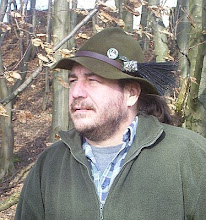 Fall in a Franconian forest where I used to hunt
Fall in a Franconian forest where I used to hunt
Destruction of the old-growth forests
This was quite bad for the ecosytem not least because not only cows and sheep were grazed in the forest but hogs as well which rummaged the leaf layer for acorns and beechnuts and even digged the ground for roots, grubs and worms. So the sensitive humus layer of the forest ground was disturbed which averted the regeneration of the wood by the growth of young trees.
Hence the population in these days was very small the depletion did not really have a big effect at first, because large areas of woodland remained untouched. But as the population growed, more and more woodland was destroyed.
So around the year 1700 so much forest was destroyed that wood had become fairly a rare good. This was quite a big problem, not only because of the shortage of timber but above all because wood in these days used to be almost the only energy carrier available.
Growing new forests
To ensure wood supply people began to plant new trees. As cultivating woods was a completely new business these early foresters didn't have any antetype than gardeners and farmers. Due to this they did it the way gardeners and farmers had been growing their plants for ages: They planted rows of trees of the same sort at the same time like gardeners plant their cabbage or salad on their garden beds. The most popular tree was the spruce becaus it grows quick and provides a wood with long fibres which is not really first choice but after all quite suitable for both construction timber and firewood.
 Oak logs in the yard of a sawmill
Oak logs in the yard of a sawmill
Beside the spruces, beeches were planted too, which are the sort of trees dominating natural-grown forests in Germany. The new forests consisted of departements which each or them contaned trees of the same sort and age. As they were planted at the same time all trees of a department where big enough to get felled at the same time. So the whole department was cut down and replanted at the same time too and so on.
Hunting since the middle ages had been the right of the gentry. The noblemen had been employing gamekeepers to look after their lagre hunting grounds. So a profession of educated hunters, a real trade with apprenticeship and things had been developing. These hunters were entrusted with keeping the woods too. With the years they figgured out more and more things about growing wood and turnd into skilled foresters. So in Germany the forest rangers traditionally have to look after both wood and game. Forestry even grew up to a real science which one can study and graduate in.
New ways in forestry
Already around the threshold of the 20th Century some foresters found out that growing wood the way they had been doing it was suboptimal: The monocultures, especially of spruce, caused a lot of problems with diseases and varmints. Growing wood this way meant a lot of work and wasn't ecological at all.
They learned that working along with nature was much more easy than working against it. They started experimenting with forests which are as similar as possible to old-growth forests. These near-natural forests contain trees of different ages and sorts as well as a shrub layer and a herb layer, natural soil layers and all the things that belong to a natural forest. They aren't cut down in whole neither, the lumbermen only cull single mature trees which is quite like old trees dying and falling down. So the forest is a persisting ecosystem and quite stable as well as it saves a lot of work and financial effort.
In Switzerland State Forest Authorithy adpated the new method very soon as early as in the 1920s or 1930. In Germany foresters in the Forests owned by the Federal States kept using the old method although some big private forest owners were quite successful with near-natural forestry. But finally, when working costs grew to much, Forest Authorithies of the federal states made up their minds to introduce near-natural forestry too. Obvioulsy the turning point was the hurricane „Wiebke“ in 1991 which destroyed huge areas of spruce monocultures and impressively showed the disadvantages of conventional forestry.
Increasing woods
Actually the quota of woodland in Germany is increasing. With the changings in agriculture some poor acreages aren't suitable for agriculture anymore and are reforested willingly. Adiitionally acreages which aren't cultivated anymore develop old-growth forest again due to climate and geological conditions. Especially heather areas are reforesting themselves because shepherding which formed them almost entirely vanished.
There are also areas of former spruce monocultures which were destroyed by the hurricane Wiebke and not reforested due to lack of money. On these areas nature has taken over and is growing the natural vegetation system according to the habitats – which is forest. Actually you can find there mainly typical pioneer trees which will be replaced by mostly beeches and other shade loving forest trees by and by within a century or two. So if man doesn't start to intervent again, old-growth forest will be there again in probably less than 200 years.










No comments:
Post a Comment